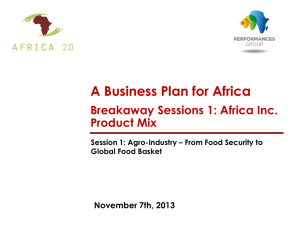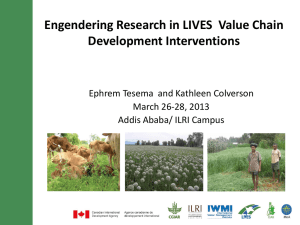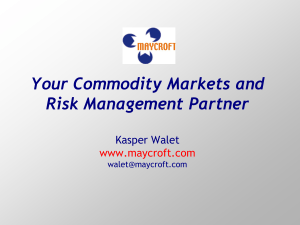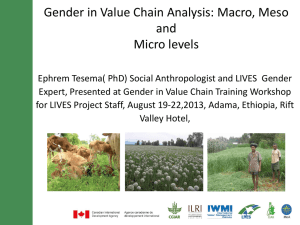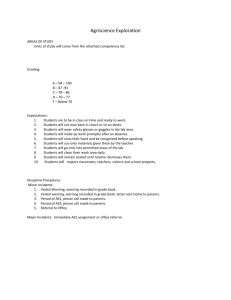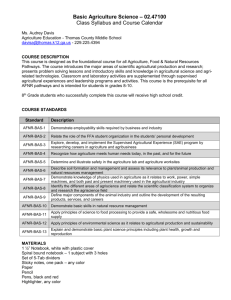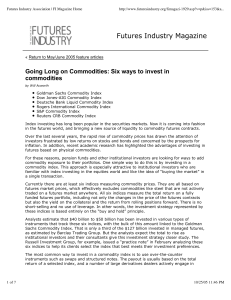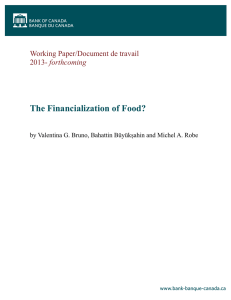Marketing in Agriscience: Strategies for Profit Maximization
advertisement
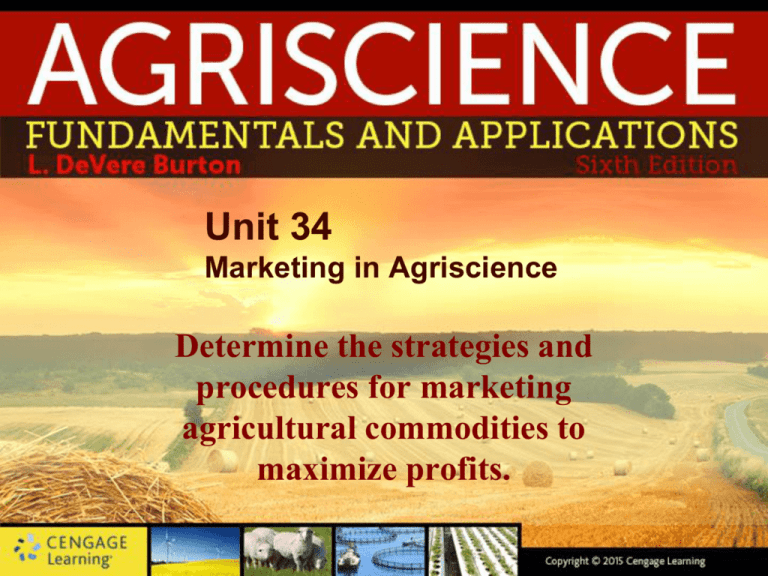
Unit 34 Marketing in Agriscience Determine the strategies and procedures for marketing agricultural commodities to maximize profits. Introduction • Factors when marketing agriscience products – – – – – – Product demand Product supply Market types/availability in the area Similar products: competition Intended consumers’ buying power Demand: seasonal variations Introduction (cont’d.) • Basics of profitability: supply and demand • Supply – Product availability at a specific time and price – Impacted by the number of people producing the product in the area • Demand – Product quantity/amount wanted at a specific time and price – Determined largely by price Focus on Consumers • Consumer demographics: categories of information about consumers or potential consumers Consumer Demographics • Marketing agriscience products: demographic categories of interest – – – – – – Population density Ethnic makeup of the population Family income Discretionary money held by family individuals Family size Eating preferences Consumer Demographics (cont’d.) • Marketing agriscience products: demographic categories of interest – – – – – Who makes buying decisions in the household? Occupation and work locations Tendencies to eat at home or away Clothing preferences Recreational preferences Advertising and Promotion • Any form of non-personal product or service presentation • Must be coordinated with other marketing techniques • Advertising types – Product – Institutional Advertising and Promotion (cont’d.) • Product displays: stores and other retail outlets • Displays and sales of machinery, animals, food, flowers, landscape designs, and other goods/services: fairs, shows, open houses, trade shows, and professional meetings • Free samples: fairs, public auctions, etc. Project • Divide into groups of 2-3 students. • Each group design a new marketing campaign for a locally produced agricultural product. • You can select to design a commercial with a script, a brochure, a poster, etc. • This must be creative, unique, and professional!!! Commodity Pricing • Producer may have little control: supply or price • Producer-owned marketing cooperatives – Negotiate price on large-volume basis – May have processing facilities: process and hold fresh commodities for better prices Commodity Pricing • Pricing approaches – – – – – Psychological Penetration Skimming Loss-leader Prestige Marketing Strategies for Maximizing Profits • Determine types of markets available • Determine costs of various types of marketing • Determine transportation costs to market at each of the available markets, and sell where transportation costs are favorable Marketing Strategies for Maximizing Profits (cont’d.) • Determine the most profitable marketing form for the product • Advertise to create new markets • Market product at the peak of demand: seasonal commodities Retail Marketing • General principles – Selling directly to consumers – Ready-to-eat products • Retail marketing locales – Farms – Roadside markets – Farmers’ markets Wholesale Marketing • Marketing through a middleman • Types of wholesale marketing – Terminal markets – Auction markets – Direct sales Hot Topics in Agriscience • Online video merchandising – Allows buyers at different locations to bid in a competitive auction for a product they have viewed on video – Popular method for selling livestock – Requires trust between the buyer, the seller, and the on-site evaluator: product quality represented accurately Wholesale Marketing (cont’d.) • Other techniques – – – – Cooperatives Vertical integration Bartering or trading Cash sales Marketing Fees and Commissions • Vary widely • Livestock sales: fee for each animal according to size • Purebred livestock sales: up to 10 percent of selling price Marketing Fees and Commissions (cont’d.) • Yardage fees: apply at terminal markets • Pencil shrink: assessed for slaughter animals for weight loss in transportation • Commodities’ sales fees: percentage of gross amount Marketing Procedures • Always handle live animals quietly and carefully. • Move animals when temperatures are moderate. • Do not overcrowd animals on trailers or in lots. Marketing Procedures (cont’d.) • Do not overfeed animals just before hauling. • Do provide ample fresh, clean water. • Avoid injuring or bruising animals when loading and unloading. Marketing Procedures (cont’d.) • Sort animals according to sex and size before shipping to market. • Precondition animals for several days before marketing them. Marketing Trends and Cycles • General price cycling causes – Supply and demand – Government intervention • Price cycles interrupted, accelerated, or delayed: disasters or political events Trends and Cycles in Animal Markets • Factors influencing livestock prices – – – – – – Importation and exportation of livestock products Development of new uses for livestock products Increased advertising of livestock products World weather conditions General economic conditions in the world Changes in consumer demands Trends and Cycles in Crop Marketing • Factors contributing to availability of food and fiber commodities – – – – – – Highway transportation system Air shipping Refrigerated shipping Food-processing procedures Storage facilities Marketing system Global Marketing in Agriscience • Factors influencing marketing changes – Modern communication devices: telephones, radios, televisions, fax machines, computers, etc. – Increasing number and types of middlemen The Agricultural Commodity Futures Market • Commodity exchange – Organization licensed to manage the process of buying and selling commodities under specific laws using a system of licensed brokers • Futures market – Procedure conducted by commodity exchanges to provide networks and legal frameworks for sellers and buyers to work through brokers in making futures The Agricultural Commodity Futures Market (cont’d.) • Important to buyers and sellers • Activities – Buying and selling futures – Opening a position – Offsetting a position Export Marketing • U.S. market – Exports large amounts of agricultural products – Increased imports of agricultural commodities: not as fast as exports • Advances making the world smaller – Increased travel abroad – Delegations: working to render goodwill; promote professional linkages; and develop markets

